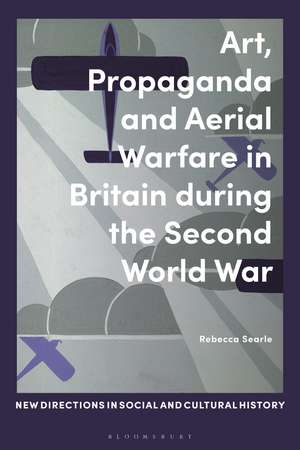Art, Propaganda and Aerial Warfare in Britain during the Second World War: New Directions in Social and Cultural History
Autor Dr. Rebecca Searleen Limba Engleză Paperback – 23 feb 2022
| Toate formatele și edițiile | Preț | Express |
|---|---|---|
| Paperback (1) | 195.81 lei 6-8 săpt. | |
| Bloomsbury Publishing – 23 feb 2022 | 195.81 lei 6-8 săpt. | |
| Hardback (1) | 596.47 lei 6-8 săpt. | |
| Bloomsbury Publishing – 19 aug 2020 | 596.47 lei 6-8 săpt. |
Preț: 195.81 lei
Preț vechi: 256.81 lei
-24% Nou
Puncte Express: 294
Preț estimativ în valută:
37.47€ • 39.12$ • 31.01£
37.47€ • 39.12$ • 31.01£
Carte tipărită la comandă
Livrare economică 04-18 aprilie
Preluare comenzi: 021 569.72.76
Specificații
ISBN-13: 9781350199125
ISBN-10: 1350199125
Pagini: 168
Ilustrații: 40 bw illus
Dimensiuni: 156 x 234 mm
Greutate: 0.24 kg
Editura: Bloomsbury Publishing
Colecția Bloomsbury Academic
Seria New Directions in Social and Cultural History
Locul publicării:London, United Kingdom
ISBN-10: 1350199125
Pagini: 168
Ilustrații: 40 bw illus
Dimensiuni: 156 x 234 mm
Greutate: 0.24 kg
Editura: Bloomsbury Publishing
Colecția Bloomsbury Academic
Seria New Directions in Social and Cultural History
Locul publicării:London, United Kingdom
Caracteristici
Analyses well-know facets of the air war, such as the Battle of Britain, the Blitz and the bombing of Germany, as well as understudied aspects, such as air production
Notă biografică
Rebecca Searle is Principal Lecturer in the Humanities at the University of Brighton, UK.
Cuprins
List of Illustrations1. Introduction2. The War Artists' Advisory Committee, Cultural Propaganda and Romantic Art3. The Battle for Production4. The Battle of Britain5. The Blitz6. The Bombing of Germany7. ConclusionBibliographyIndex
Recenzii
Rebecca Searle has written a fascinating account of the part that Kenneth Clark's War Artists' Advisory Committee (WAAC) played in reflecting and recording the British experience of the Second World War. Chapters on aircraft production, and on Britain's bombing campaign against German cities, are valuable contributions to areas that have been given little attention in our national narrative. Our understanding of the more familiar Battle of Britain and the Blitz, the subjects of Searle's other chapters, is enriched by her close attention to the visual storytelling that operated in conjunction with other mediations - whether via radio, newspapers or films - to shape the population's experience of war.
[T]his slim volume will engage and inform scholars interested in the art and propaganda in the modern state in general and twentieth-century Britain in particular.
Rebecca Searle deftly combines social and political history, history of emotions, and visual studies to present an absorbing new book on Britain in the Second World War. This inter-disciplinary, expertly researched study presents a significant challenge to received histories about the role of official war artists through its skillful re-imagining of the relationship between fine art, experience, and propaganda.
Rebecca Searle's new book skillfully places the Second World War's official artists into the broader cultural history of the conflict, especially its central feature of aerial warfare. It enables us to understand better how artists themselves balanced the demand for propaganda with their own aspirations to create enduring work. Most important, by providing such a rich context for not only the production but also the wartime consumption of these paintings, she makes us want to turn to them again, able to appreciate them in new ways.
A really stimulating book that should be read by anyone interested in wartime culture. Drawing across images and archives and with a keen eye for the complexities of the past, Rebecca Searle gives us a host of new insights into the individual, institutional and cultural factors that conditioned the visual representation of aerial warfare in Second World War Britain.
Rebecca Searle presents a fresh angle on the well-trodden subject of renowned art historian Sir Kenneth Clark.
[T]his slim volume will engage and inform scholars interested in the art and propaganda in the modern state in general and twentieth-century Britain in particular.
Rebecca Searle deftly combines social and political history, history of emotions, and visual studies to present an absorbing new book on Britain in the Second World War. This inter-disciplinary, expertly researched study presents a significant challenge to received histories about the role of official war artists through its skillful re-imagining of the relationship between fine art, experience, and propaganda.
Rebecca Searle's new book skillfully places the Second World War's official artists into the broader cultural history of the conflict, especially its central feature of aerial warfare. It enables us to understand better how artists themselves balanced the demand for propaganda with their own aspirations to create enduring work. Most important, by providing such a rich context for not only the production but also the wartime consumption of these paintings, she makes us want to turn to them again, able to appreciate them in new ways.
A really stimulating book that should be read by anyone interested in wartime culture. Drawing across images and archives and with a keen eye for the complexities of the past, Rebecca Searle gives us a host of new insights into the individual, institutional and cultural factors that conditioned the visual representation of aerial warfare in Second World War Britain.
Rebecca Searle presents a fresh angle on the well-trodden subject of renowned art historian Sir Kenneth Clark.









